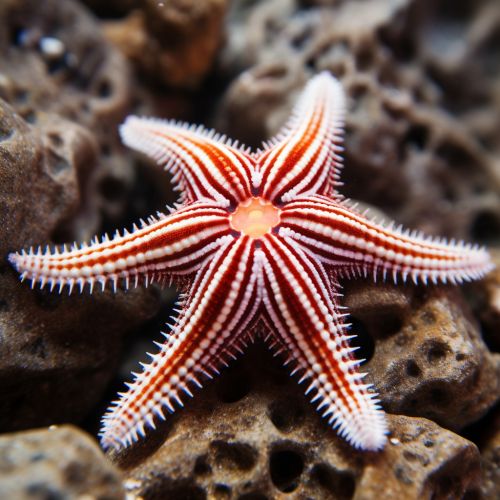Echinoderms
Introduction
Echinoderms are a phylum of marine animals found in nearly every ocean habitat. The phylum includes starfish, sea urchins, sand dollars, and sea cucumbers, among others. Echinoderms are characterized by their radial symmetry, spiny skin, and a water vascular system. The name "echinoderm" comes from the Greek words for "spiny skin". Echinoderms are unique among animals in having a body plan that is based on five-part symmetry.
Anatomy and Physiology


Echinoderms have a hard, spiny exoskeleton or skin, which is made up of plates of calcium carbonate. These plates are covered by a thin layer of skin and tiny, pincer-like structures called pedicellariae. The pedicellariae help to keep the surface of the echinoderm clean.
Echinoderms have a unique circulatory system known as a water vascular system. This system is filled with sea water and is used for a variety of functions, including locomotion, feeding, and respiration. The water vascular system is composed of a series of canals that lead to the tube feet. The tube feet are small, flexible, and often sucker-tipped, and are used for movement and feeding.
Echinoderms also have a simple nervous system that is composed of a nerve ring and radial nerves that extend along each arm or ray. They do not have a brain or centralized control center. Instead, each arm or ray of an echinoderm has a nerve cord and a set of ganglia that control the movements of that arm.
Classification and Diversity
The phylum Echinodermata is divided into five classes: Asteroidea (starfish), Ophiuroidea (brittle stars), Echinoidea (sea urchins and sand dollars), Crinoidea (sea lilies and feather stars), and Holothuroidea (sea cucumbers). Each of these classes is distinct and diverse, with its own unique characteristics and adaptations.
Asteroidea, or starfish, are perhaps the most well-known echinoderms. They are characterized by their star-shaped body, which typically has five arms, although some species have more. Starfish are predators and scavengers, feeding on a variety of foods including mollusks, crustaceans, and dead animals.
Ophiuroidea, or brittle stars, are similar to starfish but have long, slender, flexible arms that they use for locomotion. Brittle stars are typically detritivores, feeding on dead organic material.
Echinoidea includes sea urchins and sand dollars. These echinoderms have a globular or disc-shaped body and do not have arms. Instead, they have long, movable spines that they use for locomotion and defense. Sea urchins are herbivores, feeding primarily on algae, while sand dollars are detritivores.
Crinoidea, which includes sea lilies and feather stars, are the only echinoderms that are sessile as adults. They attach themselves to the substrate using a stalk and have feathery arms that they use to filter feed.
Holothuroidea, or sea cucumbers, are elongated, soft-bodied echinoderms. They are detritivores, feeding on organic material in the sediment.
Reproduction and Life Cycle
Echinoderms have a complex life cycle that includes both asexual and sexual reproduction. Many echinoderms are capable of regeneration, a form of asexual reproduction where a new individual grows from a fragment of the parent. This is particularly common in starfish and sea cucumbers.
Sexual reproduction in echinoderms typically involves the release of eggs and sperm into the water, where fertilization occurs. The fertilized eggs develop into free-swimming larvae, which undergo a process of metamorphosis to become the adult form.
Ecological Role and Importance
Echinoderms play important roles in marine ecosystems. As predators, scavengers, and detritivores, they help to control populations of other animals and recycle nutrients. Some echinoderms, like sea urchins, also play a critical role in shaping their environment. For example, sea urchins can control the distribution and abundance of algae on coral reefs, which can have significant impacts on the entire reef ecosystem.
Conservation and Threats
Like many marine species, echinoderms face a number of threats, including habitat destruction, pollution, and climate change. Overfishing is also a significant threat to some species, particularly sea cucumbers and some types of starfish that are harvested for food or the aquarium trade.
Conservation efforts for echinoderms include habitat protection, regulation of fishing, and research to better understand their biology and ecology. Some species of echinoderms are also bred in captivity as a way to reduce pressure on wild populations.
